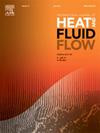Experimental visualization of dry regions formation for Falling-Film flow patterns
IF 2.6
3区 工程技术
Q2 ENGINEERING, MECHANICAL
International Journal of Heat and Fluid Flow
Pub Date : 2025-03-06
DOI:10.1016/j.ijheatfluidflow.2025.109803
引用次数: 0
Abstract
Water is essential for humans in everyday life, and plenty of fresh water is required for agricultural, chemical, industrial, and other domestic uses. Water scarcity is becoming increasingly prevalent in many regions and countries as they advance their respective growth lines. The predominant method employed in thermal desalination plants is the falling-film process due to its operational advantages. The present study examines the mapping of diverse flow patterns for heat transfer mechanisms across the horizontal tube bundle. An experimental test facility is developed, and a series of visualization experiments are conducted. The FLIR E60 infrared camera is employed to examine the liquid film behavior for different temperature profiles. The findings revealed that the droplet flow pattern induces wave-like wetting, whereas the column flow pattern induces liquid ring wetting on the tube wall. The tube wall temperature attains its maximum during droplet flow, regardless of the chosen tube spacing values. When the tube spacing is 10/20/30/40 mm, the maximum temperature of the liquid film is reached rapidly in the droplet flow, reaching values of 75.7 °C, 73 °C, 79.1 °C, 65.8 °C, 76.5 °C, 71.4 °C, 69.3 °C, and 74.2 °C, respectively, in comparison to other flow modes. The infrared photographic images show that the stabilizing tube has a faster heat transfer mechanism than the test tube. Furthermore, the liquid profile on the upper portion of the tube wall exhibits a faster evaporation rate than the lower one. The formation of dry spots on the test tubes and stabilizing tubes exhibited a distinct pattern due to distinct flow mode wetting phenomena for chosen working conditions. The research findings address various aspects of information on falling-film flow behavior and mapping of flow patterns to heat transfer mechanisms.
求助全文
约1分钟内获得全文
求助全文
来源期刊

International Journal of Heat and Fluid Flow
工程技术-工程:机械
CiteScore
5.00
自引率
7.70%
发文量
131
审稿时长
33 days
期刊介绍:
The International Journal of Heat and Fluid Flow welcomes high-quality original contributions on experimental, computational, and physical aspects of convective heat transfer and fluid dynamics relevant to engineering or the environment, including multiphase and microscale flows.
Papers reporting the application of these disciplines to design and development, with emphasis on new technological fields, are also welcomed. Some of these new fields include microscale electronic and mechanical systems; medical and biological systems; and thermal and flow control in both the internal and external environment.
 求助内容:
求助内容: 应助结果提醒方式:
应助结果提醒方式:


